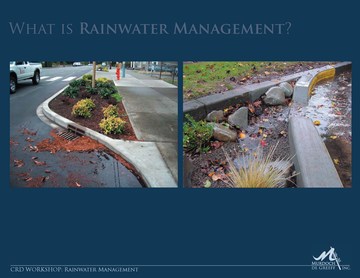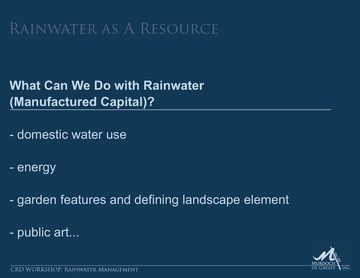Rainwater Management & Site Adaptive Planning

In November 2007, the Capital Regional District hosted a full-day workshop titled Bio/Infiltration: Tools for Rainwater Management. Organized under the umbrella of the Stormwater, Harbours and Watersheds Program, the workshop emphasis was on municipal implementation, particularly funding, bylaws and other tools available to municipalities to work towards innovative rainwater management.
The workshop featured case studies from both sides of the Georgia Basin, thereby facilitating a sharing of experiences. To read the complete story, click on Rainwater Management in the Georgia Basin: Capital Regional District workshop celebrates on-the-ground successes.
Rainwater Management Overview & Site Adaptive Planning
Paul de Greeff, landscape planner, opened his thought-provoking presentation by asking this rhetorical question: “What is innovative rainwater management, and why should we pursue it as municipalities and developers?” He then provided the following perspective:

Site Processes, Systems and Context:
According to Paul, “If we view innovative rainwater management comprehensively, it starts with an understanding of site processes, systems and context. If we don't  first understand the systems that we are designing within, and the full breadth of constraints and opportunities present on a site, fitting rainwater management systems into the landscape is a bit like making a medical diagnosis and prescription without first taking a patient history, lab tests or in any way trying to understand the patient.”
first understand the systems that we are designing within, and the full breadth of constraints and opportunities present on a site, fitting rainwater management systems into the landscape is a bit like making a medical diagnosis and prescription without first taking a patient history, lab tests or in any way trying to understand the patient.”
An appreciation that every site is different and has different needs or resiliencies is an essential first step for addressing innovative rainwater management.


Site Adaptive Planning:
'Site Adaptive Planning' is a term coined by Will Marsh, Professor Emeritus, University of Michigan. It is the practice of investigating and analysing landscape processes and attributes to understand how they function and where they are more sensitive or more resilient, and then planning how we might begin to fit development into landscapes in a manner that responds to how a site functions. Site adaptive planning requires reading sites to define and describe the working systems, extending our analysis and exploration as far as the systems go (the systems define the dimensions of the site). It also requires understanding how to design new systems that meet development goals, but also fit the existing landscape systems to achieve more sensitive, functional and hopefully sustainable solutions.
The planning and design of new development and re-development needs to be 'site adaptive' or fitted to the opportunities and constraints inherent in the landscape. This amounts to more than fitting buildings around protected trees, or avoiding the filling in of a wetland. It can also require understanding things like hydrological processes, soil characteristics, existing subsurface drainage patterns and vegetation requirements on a site, so that when we do begin to design, we can chose the right technologies to apply, respond to opportunities that may already exist on a site, and protect sensitive or valued site features and attributes.

To download a copy of the presentation by Paul de Greeff, click on this link to Site Adaptive Planning and Design.
Posted August 2008
Originally posted on the Green Infrastructure Community-of-Interest in December 2007

